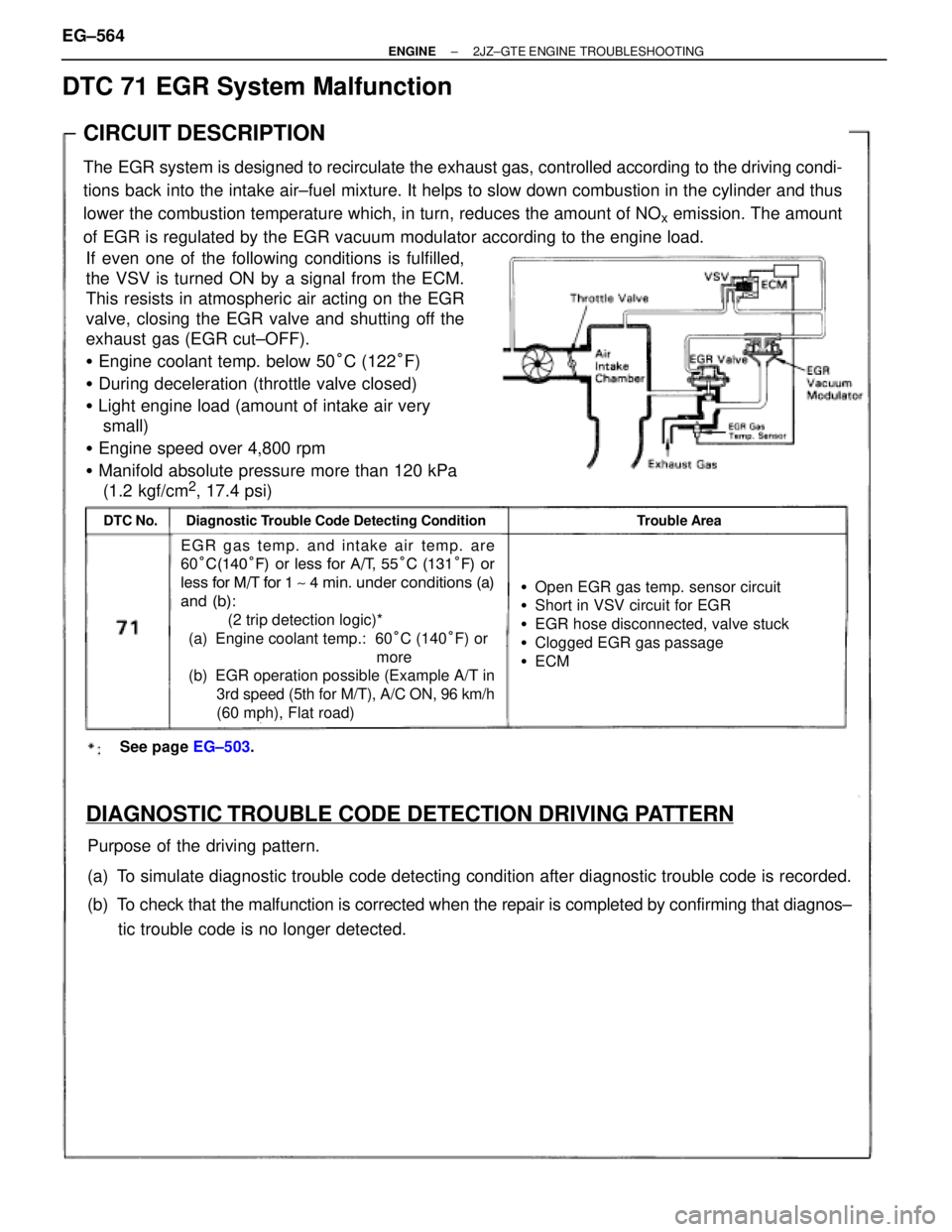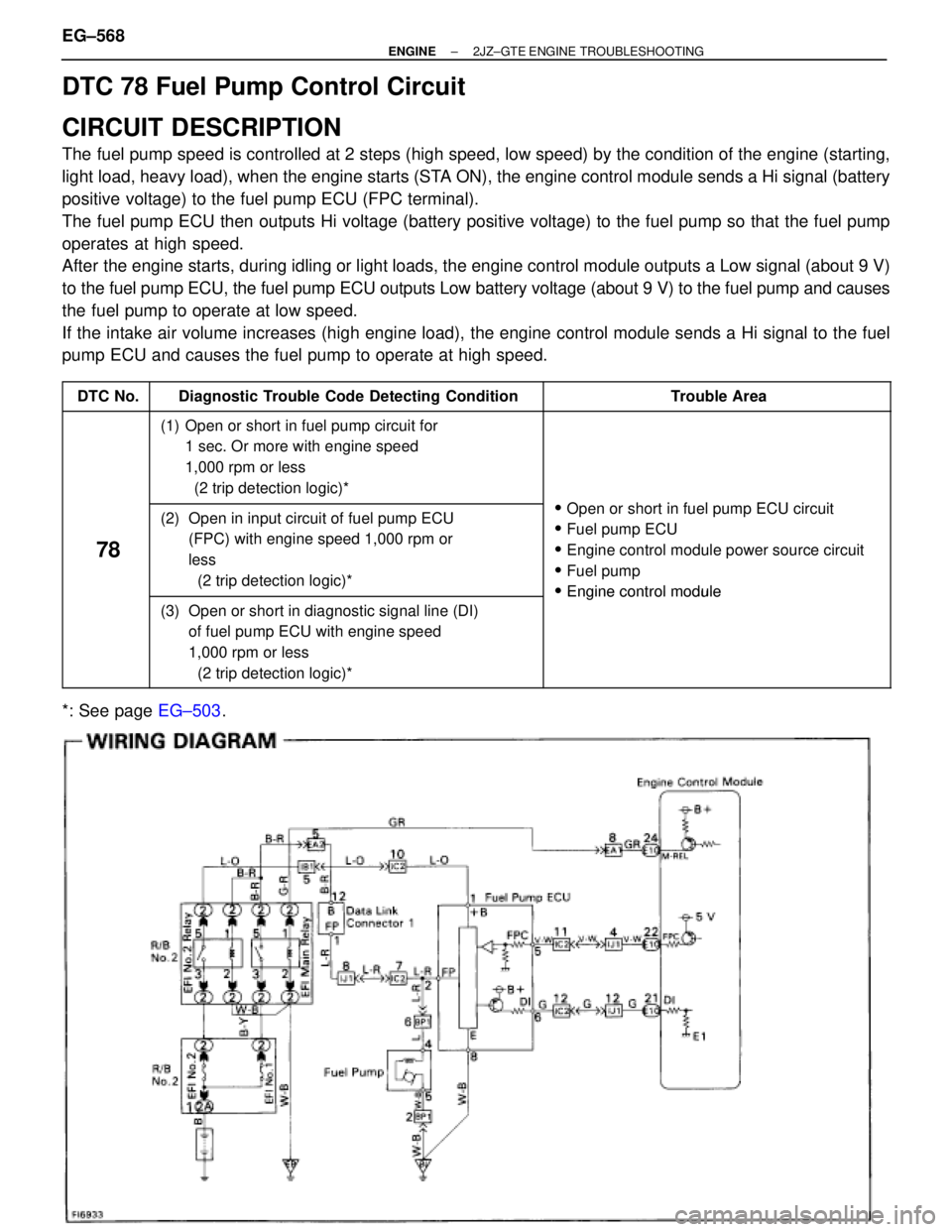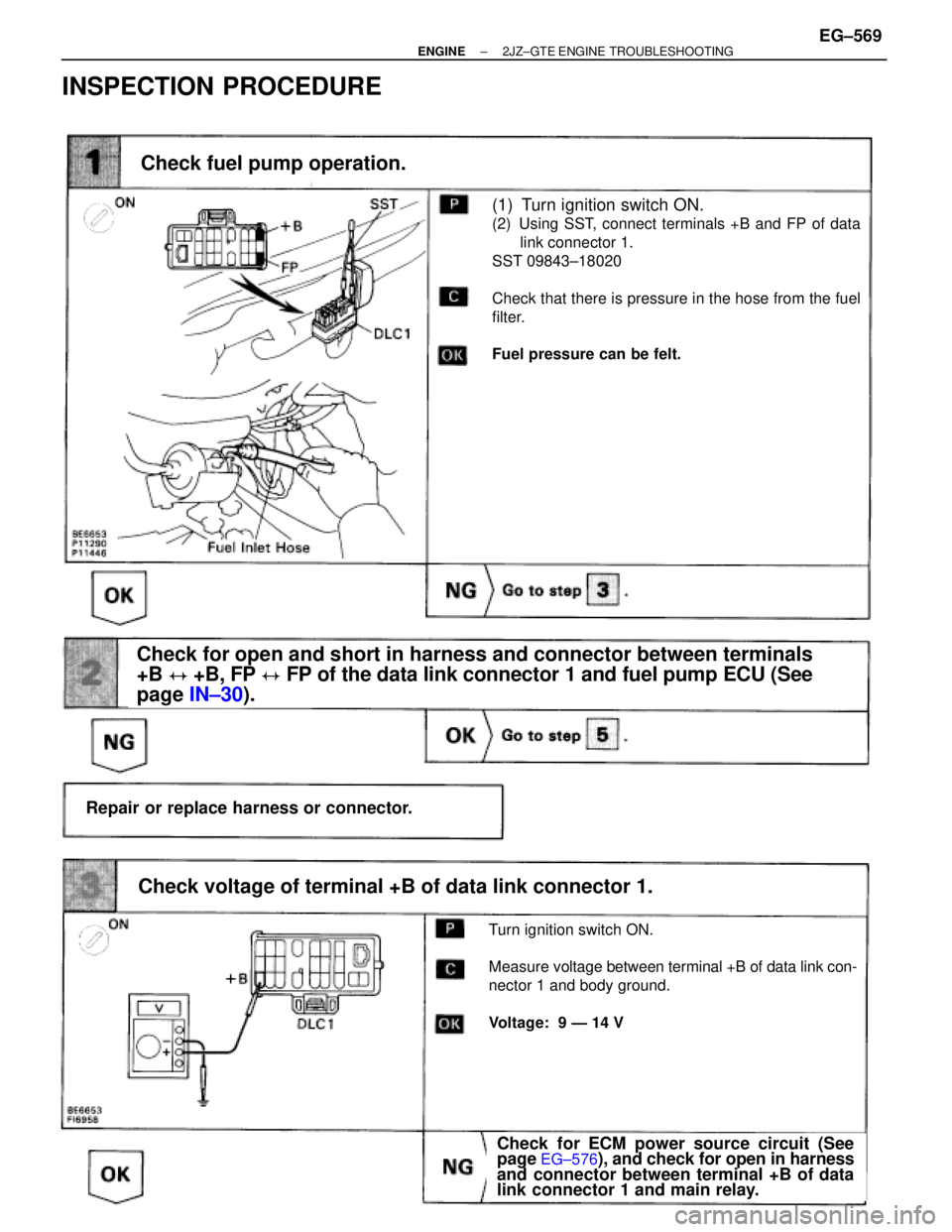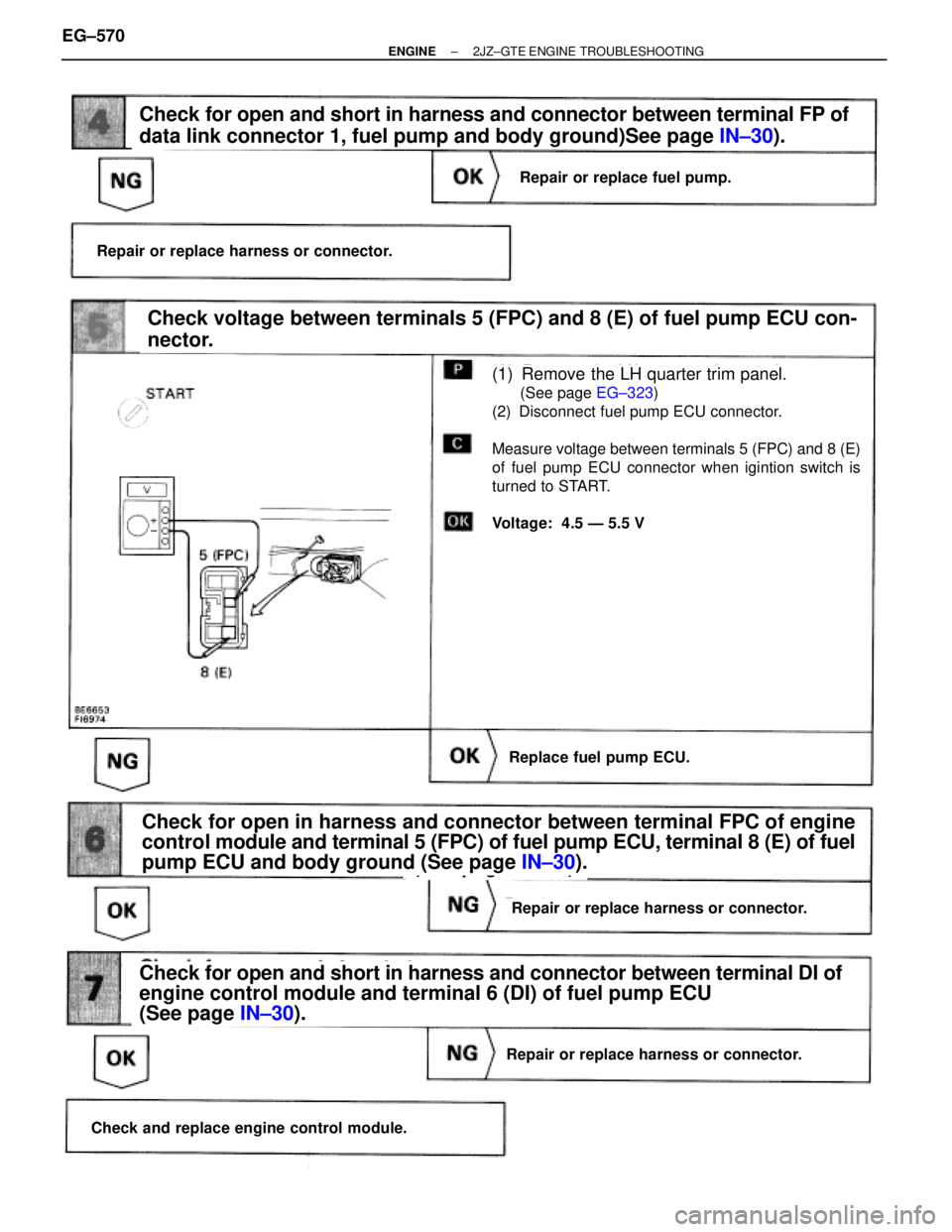Page 2070 of 2543

�With the engine racing (4,000 rpm) measure
waveform between terminals KNK1, KNK2 of
engine cotrol module and body ground.
HINT: The correct waveform is as shown.
�Spread the time on the horizontal axis, and con
firm that the period of the wave is 123 � sec.
(Normal mode vibration frequency of knock
sensor: 8.1 KHz).
HINT: If normal mode vibration frequency is not 8.1 KHz,
the sensor is malfunctioning.
(See page EG±316)
(See page IN±30.)
(See page EG±316)
Disconnect knock sensor connector.
Measure resistance between the knock sensor terminal
and body.
Resistance: 1 M� or higher
Check knock sensor.
Replace knock sensor (See page EG±316)
Check for open and short in harness and connector between engine control
module and knock sensor (See page IN±30).
Repair or replace harness or connector.
Does malfunction disappear when a good knock sensor is installed?
Replace knock sensor. (See page EG±316)
Check and replace engine control module.
± ENGINE2JZ±GTE ENGINE TROUBLESHOOTINGEG±563
Page 2071 of 2543

See page EG±503.
CIRCUIT DESCRIPTION
The EGR system is designed to recirculate the exhaust gas, controlled according to the driving condi-
tions back into the intake air±fuel mixture. It helps to slow down combustion in the cylinder and thus
lower the combustion temperature which, in turn, reduces the amount of NO
x emission. The amount
of EGR is regulated by the EGR vacuum modulator according to the engine load.
If even one of the following conditions is fulfilled,
the VSV is turned ON by a signal from the ECM.
This resists in atmospheric air acting on the EGR
valve, closing the EGR valve and shutting off the
exhaust gas (EGR cut±OFF).
� Engine coolant temp. below 50°C (122°F)
� During deceleration (throttle valve closed)
� Light engine load (amount of intake air very
small)
� Engine speed over 4,800 rpm
� Manifold absolute pressure more than 120 kPa
(1.2 kgf/cm
2, 17.4 psi)
DTC No.Diagnostic Trouble Code Detecting ConditionTrouble Area
No No.1 knock sensor signal to ECM for 4
crank revolutions with engine speed between
2,050 rpm and 5,950 rpm
�Open EGR gas temp. sensor circuit
�Short in VSV circuit for EGR
�EGR hose disconnected, valve stuck
�Clogged EGR gas passage
�ECM
EGR gas temp. and intake air temp. are
60°C(140°F) or less for A/T, 55°C (131°F) or
less for M/T for 1 ~ 4 min. under conditions (a)
and (b):
(2 trip detection logic)*
(a) Engine coolant temp.: 60°C (140°F) or
more
(b) EGR operation possible (Example A/T in
3rd speed (5th for M/T), A/C ON, 96 km/h
(60 mph), Flat road)
Purpose of the driving pattern.
(a) To simulate diagnostic trouble code detecting condition after diagnostic trouble code is recorded.
(b) To check that the malfunction is corrected when the repair is completed by confirming that diagnos±
tic trouble code is no longer detected.
DIAGNOSTIC TROUBLE CODE DETECTION DRIVING PATTERN
DTC 71 EGR System Malfunction
EG±564± ENGINE2JZ±GTE ENGINE TROUBLESHOOTING
Page 2072 of 2543
Malfunction: Open in EGR Gas Temp. Sensor Circuit
(1) Disconnect the EFI No.1 fuse (30A) for 10 sec. or more, with IG switch OFF.
Initiate test mode (Connect terminal TE2 and E1 of data link connector 2 with IG
switch OFF).
(2) Start the engine and warm up.
(3) Idle the engine for 3 min.
(4) With the A/C ON and transmission in 5th position (A/T in 3rd speed) drive at 88 96
km/h (55 60 mph) for 4 min or less.
HINT: If a malfunction exists, the malfunction indicator lamp will light up during step (4).
NOTICE: If the conditions in this test are not strictly followed, detection of the malfunction
will not be possible.
± ENGINE2JZ±GTE ENGINE TROUBLESHOOTINGEG±565
Page 2073 of 2543
INSPECTION PROCEDURE
(See page EG±310)
(See page IN±30).
(1) Connect SST (check harness ªAº).
(See page EG±510)
SST 09990±01000
(2) Warm up engine to normal operating temperature.
Measure voltage between terminal EGR of engine con-
trol module connector and body ground.
Voltage: 9 Ð 14 V
Check voltage between terminal EGR of engine control module connector
and body ground.
Check for open and short in harness and connector between EFI main relay
and VSV for EGR, VSV for EGR and engine control module (See page IN±30).
Check resistance between terminals of VSV for EGR.
Repair or replace harness or connector.
Check and replace engine control module.
Remove VSV for EGR. (See page EG±310)
Measure resistance between terminals of VSV for
EGR.
Resistance: 30 Ð 34 � at 20°C (68°F)
Replace VSV for EGR. EG±566
± ENGINE2JZ±GTE ENGINE TROUBLESHOOTING
Page 2074 of 2543
(See page EG±180).
Remove EGR gas temp. sensor.
Measure resistance between terminals of EGR gas
temp. sensor connector.
Resistance: 64 Ð 97�k at 50°C (122°F)
11 Ð 1 6�k at 100°C (212°F)
2 Ð ��k at 150°C (302°F)
Check EGR system (See page EG±180).
Repair EGR system.
Check resistance of EGR gas temp. sensor.
Replace EGR gas temp. sensor.
Repair or replace harness or connector.
Check and replace engine control module.
Check for open in harness and connector between EGR gas temp. sensor
and engine control module. (See page IN±30).
EGR Gas Temp. Sensor
± ENGINE2JZ±GTE ENGINE TROUBLESHOOTINGEG±567
Page 2075 of 2543

DTC 78 Fuel Pump Control Circuit
CIRCUIT DESCRIPTION
The fuel pump speed is controlled at 2 steps (high speed, low speed) by the condition of the engine (starting,
light load, heavy load), when the engine starts (STA ON), the engine control module sends a Hi signal (battery
positive voltage) to the fuel pump ECU (FPC terminal).
The fuel pump ECU then outputs Hi voltage (battery positive voltage) to the fuel pump so that the fuel pump
operates at high speed.
After the engine starts, during idling or light loads, the engine control module outputs a Low signal (about 9 V)
to the fuel pump ECU, the fuel pump ECU outputs Low battery voltage (about 9 V) to the fuel pump and causes
the fuel pump to operate at low speed.
If the intake air volume increases (high engine load), the engine control module sends a Hi signal to the fuel
pump ECU and causes the fuel pump to operate at high speed.
����� �
���� �����DTC No.
����������������� �
���������������� �����������������Diagnostic Trouble Code Detecting Condition
���������������� �
��������������� ����������������Trouble Area
����� �
���� �
���� �
���� �����
����������������� �
���������������� �
���������������� �
���������������� �����������������
(1) Open or short in fuel pump circuit for
1 sec. Or more with engine speed
1,000 rpm or less
(2 trip detection logic)*���������������� �
��������������� �
��������������� �
��������������� ����������������O h t i f l ECU i it����� �
���� �
���� �����
78
����������������� �
���������������� �
���������������� �����������������
(2) Open in input circuit of fuel pump ECU
(FPC) with engine speed 1,000 rpm or
less
(2 trip detection logic)*���������������� �
��������������� �
��������������� ����������������
�Open or short in fuel pump ECU circuit
�Fuel pump ECU
�Engine control module power source circuit
�Fuel pump
�Engine control module����� �
���� �
���� �
���� �����
����������������� �
���������������� �
���������������� �
���������������� �����������������
(3) Open or short in diagnostic signal line (DI)
of fuel pump ECU with engine speed
1,000 rpm or less
(2 trip detection logic)*
���������������� �
��������������� �
��������������� �
��������������� ����������������
�Engine control module
*: See page EG±503. EG±568
± ENGINE2JZ±GTE ENGINE TROUBLESHOOTING
Page 2076 of 2543

(See page IN±30).
Check for ECM power source circuit (See page
EG±576), and check for open in harness and
connector between terminal +B of data link
connector 1 and main relay.
(1) Turn ignition switch ON.
(2) Using SST, connect terminals +B and FP of data
link connector 1.
SST 09843±18020
Check that there is pressure in the hose from the fuel
filter.
Fuel pressure can be felt.
Check fuel pump operation.
Repair or replace harness or connector.
Check for open and short in harness and connector between terminals
+B � +B, FP � FP of the data link connector 1 and fuel pump ECU (See
page IN±30).
Turn ignition switch ON.
Measure voltage between terminal +B of data link con-
nector 1 and body ground.
Voltage: 9 Ð 14 V
Check voltage of terminal +B of data link connector 1.
Check for ECM power source circuit (See
page EG±576), and check for open in harness
and connector between terminal +B of data
link connector 1 and main relay.
INSPECTION PROCEDURE
± ENGINE2JZ±GTE ENGINE TROUBLESHOOTINGEG±569
Page 2077 of 2543

(See page IN±30).
(See page IN±30).(See page IN±30).
(See page EG±323)
(See page IN±30).
(1) Remove the LH quarter trim panel.
(See page EG±323)
(2) Disconnect fuel pump ECU connector.
Measure voltage between terminals 5 (FPC) and 8 (E)
of fuel pump ECU connector when igintion switch is
turned to START.
Voltage: 4.5 Ð 5.5 V
Check voltage between terminals 5 (FPC) and 8 (E) of fuel pump ECU con-
nector.
Check for open and short in harness and connector between terminal DI of
engine control module and terminal 6 (DI) of fuel pump ECU
(See page IN±30).
Check for open and short in harness and connector between terminal FP of
data link connector 1, fuel pump and body ground)See page IN±30).
Repair or replace fuel pump.
Repair or replace harness or connector.
Replace fuel pump ECU.
Check for open in harness and connector between terminal FPC of engine
control module and terminal 5 (FPC) of fuel pump ECU, terminal 8 (E) of fuel
pump ECU and body ground (See page IN±30).
Repair or replace harness or connector.
Repair or replace harness or connector.
Check and replace engine control module.
EG±570± ENGINE2JZ±GTE ENGINE TROUBLESHOOTING